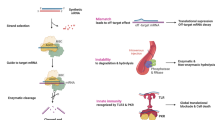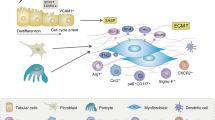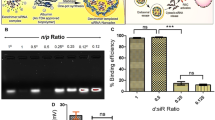Abstract
Current treatments for glomerulonephritis are not satisfactory, and the development of new therapies would be indispensable. Short interfering RNAs (siRNAs) are promising candidates for molecular therapy because of their strong and specific gene-silencing effects. Despite rapid progress in research into the therapeutic uses of siRNAs, however, many hurdles must be overcome before siRNA-based therapies can be brought to the clinic. Most in vivo studies of siRNA-based therapy have been limited to local administration or delivery to specific target organs, including the liver. Therapies based on siRNAs for patients with glomerulonephritis show promise, although tissue-specific protocols using siRNAs have not yet been established for this indication. This Review aims to provide an overview of the current challenges in siRNA-based therapy, primarily with respect to glomerular targeting. In addition, novel delivery approaches for glomerulus-targeted, siRNA-based therapies are described.
Key Points
-
Short interfering RNAs (siRNAs) are promising therapeutic tools because of their strong gene-silencing effects and high selectivity
-
Appropriate delivery vehicles are needed for the application of siRNA-based therapy
-
Glomerulus-targeted therapy is not yet established because of the lack of a definitive delivery system
-
siRNA delivery vehicles based on block copolymers are superior to previously used vehicles, owing to their stability in the bloodstream, small size, safety, and efficient drug release
-
Block copolymers are suitable as vehicles for siRNA-based therapy in the treatment of glomerulonephritis
This is a preview of subscription content, access via your institution
Access options
Subscribe to this journal
Receive 12 print issues and online access
$209.00 per year
only $17.42 per issue
Buy this article
- Purchase on Springer Link
- Instant access to full article PDF
Prices may be subject to local taxes which are calculated during checkout



Similar content being viewed by others
References
Perico, N., Benigni, A. & Remuzzi, G. Present and future drug treatments for chronic kidney diseases: evolving targets in renoprotection. Nat. Rev. Drug Discov. 7, 936–953 (2008).
Keith, D. S., Nichols, G. A., Gullion, C. M., Brown, J. B. & Smith, D. H. Longitudinal follow-up and outcomes among a population with chronic kidney disease in a large managed care organization. Arch. Intern. Med. 164, 659–663 (2004).
Sarnak, M. J. et al. Kidney disease as a risk factor for development of cardiovascular disease: a statement from the American Heart Association Councils on Kidney in Cardiovascular Disease, High Blood Pressure Research, Clinical Cardiology, and Epidemiology and Prevention. Circulation 108, 2154–2169 (2003).
Maschio, G. et al. Effect of the angiotensin-converting-enzyme inhibitor benazepril on the progression of chronic renal insufficiency. The Angiotensin-Converting-Enzyme Inhibition in Progressive Renal Insufficiency Study Group. N. Engl. J. Med. 334, 939–945 (1996).
Brenner, B. M. et al. Effects of losartan on renal and cardiovascular outcomes in patients with type 2 diabetes and nephropathy. N. Engl. J. Med. 345, 861–869 (2001).
Shimizu, H. et al. siRNA-based therapy ameliorates glomerulonephritis. J. Am. Soc. Nephrol. 21, 622–633 (2010).
Imai, E., Takabatake, Y., Mizui, M. & Isaka, Y. Gene therapy in renal diseases. Kidney Int. 65, 1551–1555 (2004).
Fire, A. et al. Potent and specific genetic interference by double-stranded RNA in Caenorhabditis elegans. Nature 391, 806–811 (1998).
Elbashir, S. M. et al. Duplexes of 21-nucleotide RNAs mediate RNA interference in cultured mammalian cells. Nature 411, 494–498 (2001).
Bernstein, E., Caudy, A. A., Hammond, S. M. & Hannon, G. J. Role for a bidentate ribonuclease in the initiation step of RNA interference. Nature 409, 363–366 (2001).
Rand, T. A., Ginalski, K., Grishin, N. V. & Wang, X. Biochemical identification of Argonaute 2 as the sole protein required for RNA-induced silencing complex activity. Proc. Natl Acad. Sci. USA 101, 14385–14389 (2004).
Martinez, J., Patkaniowska, A., Urlaub, H., Lührmann, R. & Tuschl, T. Single-stranded antisense siRNAs guide target RNA cleavage in RNAi. Cell 110, 563–574 (2002).
Matranga, C., Tomari, Y., Shin, C., Bartel, D. P. & Zamore, P. D. Passenger-strand cleavage facilitates assembly of siRNA into Ago2-containing RNAi enzyme complexes. Cell 123, 607–620 (2005).
Ameres, S. L., Martinez, J. & Schroeder, R. Molecular basis for target RNA recognition and cleavage by human RISC. Cell 130, 101–112 (2007).
Hutvágner, G. & Zamore, P. D. A microRNA in a multiple-turnover RNAi enzyme complex. Science 297, 2056–2060 (2002).
Bartlett, D. W. & Davis, M. E. Insights into the kinetics of siRNA-mediated gene silencing from live-cell and live-animal bioluminescent imaging. Nucleic Acids Res. 34, 322–333 (2006).
McCaffrey, A. P. et al. RNA interference in adult mice. Nature 418, 38–39 (2002).
Check, E. A crucial test. Nat. Med. 11, 243–244 (2005).
Chappelow, A. V. & Kaiser, P. K. Neovascular age-related macular degeneration: potential therapies. Drugs 68, 1029–1036 (2008).
Akhtar, S. & Benter, I. F. Nonviral delivery of synthetic siRNAs in vivo. J. Clin. Invest. 117, 3623–3632 (2007).
Whitehead, K. A., Langer, R. & Anderson, D. G. Knocking down barriers: advances in siRNA delivery. Nat. Rev. Drug Discov. 8, 129–138 (2009).
Castanotto, D. & Rossi, J. J. The promises and pitfalls of RNA-interference-based therapeutics. Nature 457, 426–433 (2009).
Kim, S. S., Garg, H., Joshi, A. & Manjunath, N. Strategies for targeted nonviral delivery of siRNAs in vivo. Trends Mol. Med. 15, 491–500 (2009).
Singh, S. K. & Hajeri, P. B. siRNAs: their potential as therapeutic agents—Part II. Methods of delivery. Drug Discov. Today 14, 859–865 (2009).
Takahashi, Y., Nisikawa, M. & Takakura, Y. Nonviral vector-mediated RNA interference: its gene silencing characteristics and important factors to achieve RNAi-based gene therapy. Adv. Drug Deliv. Rev. 61, 760–766 (2009).
Savaskan, N. E. et al. Small interfering RNA-mediated xCT silencing in gliomas inhibits neurodegeneration and alleviates brain edema. Nat. Med. 14, 629–632 (2008).
Palliser, D. et al. An siRNA-based microbicide protects mice from lethal herpes simplex virus 2 infection. Nature 439, 89–94 (2006).
Akinc, A. et al. A combinatorial library of lipid-like materials for delivery of RNAi therapeutics. Nat. Biotechnol. 26, 561–569 (2008).
DeVincenzo, J. et al. Evaluation of the safety, tolerability and pharmacokinetics of ALN-RSV01, a novel RNAi antiviral therapeutic directed against respiratory syncytial virus (RSV). Antiviral Res. 77, 225–231 (2008).
Hickerson, R. P. et al. Single-nucleotide-specific siRNA targeting in a dominant-negative skin model. J. Invest. Dermatol. 128, 594–605 (2008).
Poeck, H. et al. 5′-triphosphate-siRNA: turning gene silencing and Rig-I activation against melanoma. Nat. Med. 14, 1256–1263 (2008).
Zimmermann, T. S. et al. RNAi-mediated gene silencing in non-human primates. Nature 441, 111–114 (2006).
Alexis, F., Pridgen, E., Molnar, L. K. & Farokhzad, O. C. Factors affecting the clearance and biodistribution of polymeric nanoparticles. Mol. Pharm. 5, 505–515 (2008).
van de Water, F. M. et al. Intravenously administered short interfering RNA accumulates in the kidney and selectively suppresses gene function in renal proximal tubules. Drug Metab. Dispos. 34, 1393–1397 (2006).
Morrissey, D. V. et al. Potent and persistent in vivo anti-HBV activity of chemically modified siRNAs. Nat. Biotechnol. 23, 1002–1007 (2005).
Soutschek, J. et al. Therapeutic silencing of an endogenous gene by systemic administration of modified siRNAs. Nature 432, 173–178 (2004).
Zámecník, J., Vargová, L., Homola, A., Kodet, R. & Syková, E. Extracellular matrix glycoproteins and diffusion barriers in human astrocytic tumors. Neuropathol. Appl. Neurobiol. 30, 338–350 (2004).
Detzer, A., Overhoff, M., Mescalchin, A., Rompf, M. & Sczakiel, G. Phosphorothioate-stimulated cellular uptake of siRNA: a cell culture model for mechanistic studies. Curr. Pharm. Des. 14, 3666–3673 (2008).
Oliveira, S., van Rooy, I., Kranenburg, O., Storm, G. & Schiffelers, R. M. Fusogenic peptides enhance endosomal escape improving siRNA-induced silencing of oncogenes. Int. J. Pharm. 331, 211–214 (2007).
Gilmore, I. R., Fox, S. P., Hollins, A. J. & Akhtar, S. Delivery strategies for siRNA-mediated gene silencing. Curr. Drug Deliv. 3, 147–155 (2006).
Kawakami, S. & Hashida, M. Targeted delivery systems of small interfering RNA by systemic administration. Drug Metab. Pharmacokinet. 22, 142–151 (2007).
Akhtar, S. & Benter, I. Toxicogenomics of non-viral drug delivery systems for RNAi: potential impact on siRNA-mediated gene silencing activity and specificity. Adv. Drug Deliv. Rev. 59, 164–182 (2007).
Shen, C. Buck, A. K., Liu, X., Winkler, M. & Reske, S. N. Gene silencing by adenovirus-delivered siRNAs. FEBS Lett. 539, 111–114 (2003).
Maguire, A. M. et al. Safety and efficacy of gene transfer for Leber's congenital amaurosis. N. Engl. J. Med. 358, 2240–2248 (2008).
Huang, B. et al. High-capacity adenoviral vector-mediated reduction of Huntingtin aggregate load in vitro and in vivo. Hum. Gene Ther. 18, 303–311 (2007).
Hacein-Bey-Abina, S. et al. A serious adverse event after successful gene therapy for X-linked severe combined immunodeficiency. N. Engl. J. Med. 348, 255–256 (2003).
Barquinero, J., Eixarch, H. & Pérez-Melgosa, M. Retroviral vectors: new applications for an old tool. Gene Ther. 11 (Suppl. 1), S3–S9 (2004).
Lambeth, L. S., Zhao, Y., Smith, L. P., Kgosana, L. & Nair, V. Targeting Marek's disease virus by RNA interference delivered from a herpesvirus vaccine. Vaccine 27, 298–306 (2009).
Suzuki, H., Tamai, N., Habu, Y., Chang, M. O. & Takaku, H. Suppression of hepatitis C virus replication by baculovirus vector-mediated short-hairpin RNA expression. FEBS Lett. 582, 3085–3089 (2008).
Martin, S. E. & Caplen, N. J. Applications of RNA interference in mammalian systems. Annu. Rev. Genomics Hum. Genet. 8, 81–108 (2007).
Lewis, D. L. & Wolff, J. A. Systemic siRNA delivery via hydrodynamic intravascular injection. Adv. Drug Deliv. Rev. 59, 115–123 (2007).
Giladi, H. et al. Small interfering RNA inhibits hepatitis B virus replication in mice. Mol. Ther. 8, 769–776 (2003).
Klein, C. et al. Inhibition of hepatitis B virus replication in vivo by nucleoside analogues and siRNA. Gastroenterology 125, 9–18 (2003).
Morrissey, D. V. et al. Activity of stabilized short interfering RNA in a mouse model of hepatitis B virus replication. Hepatology 41, 1349–1356 (2005).
Sebestyén, M. G. et al. Mechanism of plasmid delivery by hydrodynamic tail vein injection. I. Hepatocyte uptake of various molecules. J. Gene Med. 8, 852–873 (2006).
Yuan, H. et al. Effects of cholesterol-tagged small interfering RNAs targeting 12/15-lipoxygenase on parameters of diabetic nephropathy in a mouse model of type 1 diabetes. Am. J. Physiol. Renal Physiol. 295, F605–F617 (2008).
Judge, A. D. et al. Sequence-dependent stimulation of the mammalian innate immune response by synthetic siRNA. Nat. Biotechnol. 23, 457–462 (2005).
Moore, V. A., Dunnion, D. J., Brown, T., Irwin, W. J. & Akhtar, S. Interaction of oligonucleotide-conjugates with the dipeptide transporter system in Caco-2 cells. Biochem. Pharmacol. 53, 1223–1228 (1997).
Akinc, A. et al. A combinatorial library of lipid-like materials for delivery of RNAi therapeutics. Nat. Biotechnol. 26, 561–569 (2008).
Frank-Kamenetsky, M. et al. Therapeutic RNAi targeting PCSK9 acutely lowers plasma cholesterol in rodents and LDL cholesterol in nonhuman primates. Proc. Natl Acad. Sci. USA 105, 11915–11920 (2008).
Sato, Y. et al. Resolution of liver cirrhosis using vitamin A-coupled liposomes to deliver siRNA against a collagen-specific chaperone. Nat. Biotechnol. 26, 431–442 (2008).
Geisbert, T. W. et al. Postexposure protection of guinea pigs against a lethal Ebola virus challenge is conferred by RNA interference. J. Infect. Dis. 193, 1650–1657 (2006).
Ma, Z. et al. Cationic lipids enhance siRNA-mediated interferon response in mice. Biochem. Biophys. Res. Commun. 330, 755–759 (2005).
Hollins, A. J., Omidi, Y., Benter, I. F. & Akhtar, S. Toxicogenomics of drug delivery systems: exploiting delivery system-induced changes in target gene expression to enhance siRNA activity. J. Drug Target. 15, 83–88 (2007).
Rust, D. M. & Jameson, G. The novel lipid delivery system of amphotericin B: drug profile and relevance to clinical practice. Oncol. Nurs. Forum 25, 35–48 (1998).
Boussif, O. et al. A versatile vector for gene and oligonucleotide transfer into cells in culture and in vivo: polyethylenimine. Proc. Natl Acad. Sci. USA 92, 7297–7301 (1995).
Putnam, D. Polymers for gene delivery across length scales. Nat. Mater. 5, 439–451 (2006).
Lungwitz, U., Breunig, M., Blunk, T. & Göpferich, A. Polyethylenimine-based non-viral gene delivery systems. Eur. J. Pharm. Biopharm. 60, 247–266 (2005).
Zintchenko, A., Philipp, A., Dehshahri, A. & Wagner, E. Simple modifications of branched PEI lead to highly efficient siRNA carriers with low toxicity. Bioconjug. Chem. 19, 1448–1455 (2008).
Urban-Klein, B., Werth, S., Abuharbeid, S., Czubayko, F. & Aigner, A. RNAi-mediated gene-targeting through systemic application of polyethylenimine (PEI)-complexed siRNA in vivo. Gene Ther. 12, 461–466 (2005).
Ge, Q. et al. Inhibition of influenza virus production in virus-infected mice by RNA interference. Proc. Natl Acad. Sci. USA 101, 8676–8681 (2004).
Kichler, A. Gene transfer with modified polyethylenimines. J. Gene Med. 6 (Suppl. 1), S3–S10 (2004).
Kircheis, R., Wightman, L. & Wagner, E. Design and gene delivery activity of modified polyethylenimines. Adv. Drug Deliv. Rev. 53, 341–358 (2001).
Sato, A. et al. Polymer brush-stabilized polyplex for a siRNA carrier with long circulatory half-life. J. Control. Release 122, 209–216 (2007).
Kim, S. H., Jeong, J. H., Lee, S. H., Kim, S. W. & Park, T. G. Local and systemic delivery of VEGF siRNA using polyelectrolyte complex micelles for effective treatment of cancer. J. Control. Release 129, 107–116 (2008).
Bae, Y. & Kataoka, K. Intelligent polymeric micelles from functional poly(ethylene glycol)-poly(amino acid) block copolymers. Adv. Drug Deliv. Rev. 61, 768–784 (2009).
Nishiyama, N. & Kataoka, K. Current state, achievements, and future prospects of polymeric micelles as nanocarriers for drug and gene delivery. Pharmacol. Ther. 112, 630–648 (2006).
Harada-Shiba, M. et al. Polyion complex micelles as vectors in gene therapy—pharmacokinetics and in vivo gene transfer. Gene Ther. 9, 407–414 (2002).
Harada, A., Togawa, H. & Kataoka, K. Physicochemical properties and nuclease resistance of antisense-oligodeoxynucleotides entrapped in the core of polyion complex micelles composed of poly(ethylene glycol)-poly(L-lysine) block copolymers. Eur. J. Pharm. Sci. 13, 35–42 (2001).
Akagi, D. et al. Biocompatible micellar nanovectors achieve efficient gene transfer to vascular lesions without cytotoxicity and thrombus formation. Gene Ther. 14, 1029–1038 (2007).
Matsumura, Y. & Maeda, H. A new concept for macromolecular therapeutics in cancer chemotherapy: mechanism of tumoritropic accumulation of proteins and the antitumor agent smancs. Cancer Res. 46, 6387–6392 (1986).
Jain, R. K. et al. Angiogenesis in brain tumors. Nat. Rev. Neurosci. 8, 610–622 (2007).
Dreher, M. R. et al. Tumor vascular permeability, accumulation, and penetration of macromolecular drug carriers. J. Natl Cancer Inst. 98, 335–344 (2006).
Matsumoto, S. et al. Environment-responsive block copolymer micelles with a disulfide crosslinked core for enhanced siRNA delivery. Biomacromolecules 10, 119–127 (2009).
Kim, H. J. et al. Introduction of stearoyl moieties into a biocompatible cationic polyaspartamide derivative, PAsp(DET), with endosomal escaping function for enhanced siRNA-mediated gene knockdown. J. Control. Release 145, 141–148 (2010).
Takemoto, H. et al. Polyion complex stability and gene silencing efficiency with a siRNA-grafted polymer delivery system. Biomaterials 31, 8097–8105 (2010).
Matsumura, Y. et al. Phase I clinical trial and pharmacokinetic evaluation of NK911, a micelle-encapsulated doxorubicin. Br. J. Cancer 91, 1775–1781 (2004).
Hamaguchi, T. et al. A phase I and pharmacokinetic study of NK105, a paclitaxel-incorporating micellar nanoparticle formulation. Br. J. Cancer 97, 170–176 (2007).
Minchin, R. Nanomedicine: sizing up targets with nanoparticles. Nat. Nanotechnol. 3, 12–13 (2008).
Jiang, W., Kim, B. Y., Rutka, J. T. & Chan, W. C. Nanoparticle-mediated cellular response is size-dependent. Nat. Nanotechnol. 3, 145–150 (2008).
Kriz, W., Elger, M., Lemley, K. & Sakai, T. Structure of the glomerular mesangium: a biomechanical interpretation. Kidney Int. Suppl. 30, S2–S9 (1990).
Isaka, Y. et al. Glomerulosclerosis induced by in vivo transfection of transforming growth factor-β or platelet-derived growth factor gene into the rat kidney. J. Clin. Invest. 92, 2597–2601 (1993).
Maeshima, Y. et al. Inhibition of mesangial cell proliferation by E2F decoy oligodeoxynucleotide in vitro and in vivo. J. Clin. Invest. 101, 2589–2597 (1998).
Tomita, N. et al. In vivo administration of a nuclear transcription factor-κB decoy suppresses experimental crescentic glomerulonephritis. J. Am. Soc. Nephrol. 11, 1244–1252 (2000).
Takabatake, Y. et al. Exploring RNA interference as a therapeutic strategy for renal disease. Gene Ther. 12, 965–973 (2005).
Mukai, H., Kawakami, S. & Hashida, M. Renal press-mediated transfection method for plasmid DNA and siRNA to the kidney. Biochem. Biophys. Res. Commun. 372, 383–387 (2008).
Tuffin, G., Waelti, E., Huwyler, J., Hammer, C. & Marti, H. P. Immunoliposome targeting to mesangial cells: a promising strategy for specific drug delivery to the kidney. J. Am. Soc. Nephrol. 16, 3295–3305 (2005).
Asgeirsdóttir, S. A. et al. Inhibition of proinflammatory genes in anti-GBM glomerulonephritis by targeted dexamethasone-loaded AbEsel liposomes. Am. J. Physiol. Renal Physiol. 294, F554–F561 (2008).
Robbins, M. et al. Misinterpreting the therapeutic effects of small interfering RNA caused by immune stimulation. Hum. Gene Ther. 19, 991–999 (2008).
Kleinman, M. E. et al. Sequence- and target-independent angiogenesis suppression by siRNA via TLR3. Nature 452, 591–597 (2008).
Judge, A. & MacLachan, I. Overcoming the innate immune response to small interfering RNA. Hum. Gene Ther. 19, 111–124 (2008).
Takahashi, Y., Nishikawa, M., Suehara, T., Takiguchi, N. & Takakura, Y. Gene silencing of β-catenin in melanoma cells retards their growth but promotes the formulation of pulmonary metastasis in mice. Int. J. Cancer 123, 2315–2320 (2008).
Chen, P. Y. et al. Strand-specific 5′-O-methylation of siRNA duplexes controls guide strand selection and targeting specificity. RNA 14, 263–274 (2008).
Oba, M. et al. Cyclic RGD peptide-conjugated polyplex micelles as a targetable gene delivery system directed to cells prossessing αvβ3 and αvβ5 integrins. Bioconjung. Chem. 18, 1415–1423 (2007).
Krishna, M. & Narang, H. The complexity of mitogen-activated protein kinases (MAPKs) made simple. Cell. Mol. Life Sci. 65, 3525–3544 (2008).
Kreidberg, J. A. siRNA therapy for glomerulonephritis. J. Am. Soc. Nephrol. 21, 549–551 (2010).
Acknowledgements
The authors thank Y. Hori, S. Kaname, K. Kataoka, and N. Nishiyama for useful advice and criticism during the preparation of this paper.
Author information
Authors and Affiliations
Contributions
H. Shimizu wrote the article and provided a substantial contribution to discussions of the content. T. Fujita provided substantial contributions to discussion of the content, as well as to reviewing and editing of the manuscript before submission.
Corresponding author
Ethics declarations
Competing interests
The authors declare no competing financial interests.
Rights and permissions
About this article
Cite this article
Shimizu, H., Fujita, T. New short interfering RNA-based therapies for glomerulonephritis. Nat Rev Nephrol 7, 407–415 (2011). https://doi.org/10.1038/nrneph.2011.61
Published:
Issue Date:
DOI: https://doi.org/10.1038/nrneph.2011.61



